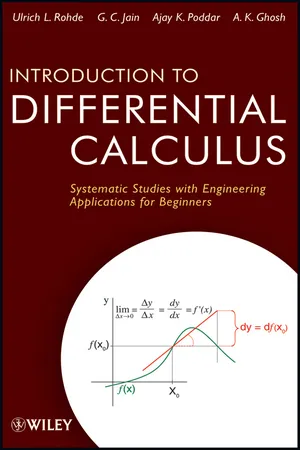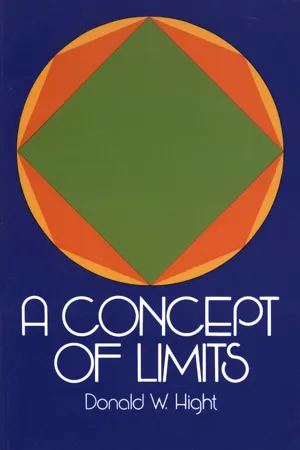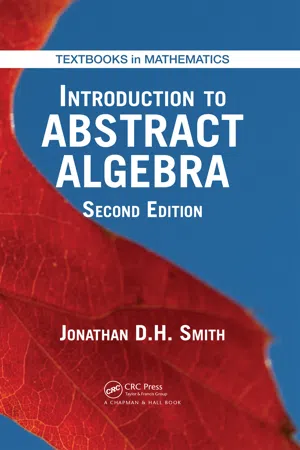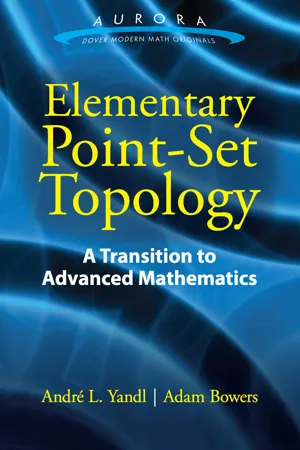Mathematics
Composition of Functions
Composition of functions is a mathematical operation that involves combining two or more functions to create a new function. The output of one function is used as the input for another function, and the resulting function is called the composite function. This operation is denoted by the symbol "∘".
Written by Perlego with AI-assistance
Related key terms
Related key terms
1 of 4
Related key terms
1 of 3
7 Key excerpts on "Composition of Functions"
- eBook - ePub
Memory and the Computational Brain
Why Cognitive Science will Transform Neuroscience
- C. R. Gallistel, Adam Philip King(Authors)
- 2011(Publication Date)
- Wiley-Blackwell(Publisher)
Composition of Functions . It is a major aspect of the writing of computer programs, because the commands in a computer program generally invoke functions, and the results are then often operated on by functions invoked by later commands.Categorization schemes are functions, as f 1 in Figure 3.2 illustrates. Categorization is commonly hierarchical, and this is captured by the Composition of Functions, as shown in Figure 3.2 .In composing functions, it usually matters which one operates first and which second. If we feed numbers to the doubling function first and then to the squaring function, we map the number 3 to 36, but if we feed first to the squaring function and then to the doubling function, we map 3 to 18. Thus, the Composition of Functions is not in general commutative: it is often the case f b ° f a ≠ f a ° f b , where ° denotes composition. In alternative notation, f b (f a (x )) ≠ f a (f b (x )). The alternative notation has the advantage of making it more apparent which function operates first (the innermost). The example of functional composition in Figure 3.2 shows that not only is the Composition of Functions commonly not commutative, it may well be the case that two functions can compose in one order but not in the reverse order. In Figure 3.2 , one could not first apply the categorization in f 2 and then apply the categorization in f 1 , because the range of f 2 is not in the domain of f 1 .The non-commutative property of the Composition of Functions suggests that any physically realizable system that computes such functions must be capable of sequencing in time the order of the individual functions. In turn, this implies that such computing devices must be capable of carrying the values of functions forward in time such that they can be utilized by functions that are sequenced later. Most of the functions that brains routinely compute involve the Composition of Functions that are determined at different points in time (numerous examples are in Chapters 11–13). In the language of computer science, one would say that a physically realized computational device, such as the brain, needs memory to carry the values forward in time, and that this memory must be capable of being written to and read from. - eBook - ePub
Introduction to Differential Calculus
Systematic Studies with Engineering Applications for Beginners
- Ulrich L. Rohde, G. C. Jain, Ajay K. Poddar, A. K. Ghosh(Authors)
- 2012(Publication Date)
- Wiley(Publisher)
Chapter 2 The Concept of a Function 2.1 IntroductionThe concept of a “function” is one of the most basic in all of mathematics. The meaning of the word “function ” has evolved and changed during the last three centuries . Its modern meaning is much broader and deeper than its elementary meaning from earlier days. The statement: “y is a function of x ” means something very much like “y is related to x by some formula ”. In fact, this statement gives some idea about a function, but it is incomplete. In traditional algebra, x and y stand for numbers. But today, functions can be defined that have nothing to do with numbers .In our study of calculus, we shall be mostly concerned with functions, which are related to numbers. Like any other mathematical concept, the concept of function is nicely expressed through the language of sets . Therefore, it is useful to revise “Elementary Set Theory ” (see Appendix “A”).Assuming the knowledge of Elementary Set Theory, we define two important terms: (i) ordered pairs and (ii) Cartesian product of sets . These terms are needed to define a “function” on the basis of set theory. Let us discuss:i. Ordered Pairs : When we wish to consider a pair of things as a whole , we may use the terms couple or just pair . If A = {1, 2, 3, 4} then the subsets {1, 2}, {1, 3}, {1, 4}, {2, 1}, {3, 1} are some examples of pairs. Here we have listed some pairs twice ; for example {1, 2} = {2, 1} and {1, 3} = {3, 1}.We know that the order, in which the elements of a set are written, is immaterial . If in a pair we wish to single out one element as being the first, then the other element becomes the second. Once we define the procedure of fixing the position of first element (in a pair), we have example of an ordered pair - eBook - ePub
- Donald W. Hight(Author)
- 2012(Publication Date)
- Dover Publications(Publisher)
Another important method of combining two functions is by composition. If f is the “squarer” function {(x, x2 )} and g is {(x, x + 1)} which we may call the “boost-one” function, then the composite function, f of g, is {(x, (x + l)2 )} which could be called the “square of the boost-one” function. The composite function, g of f which we could describe verbally by the name “the boost-one of the square” function, would be {(x, x2 + 1)}. Note that f of g and g of f are not the same functions.A definition is in the offing and should be anticipated by you. A word of caution is pertinent, however, concerning the domain of a composite function. Informally and intuitively the problem should be formulated in the following questions: “If the square root function was working on the boostone function, , what values could be used for x?” In precise terms, “If F = {(x, )}, x ≥ 0 and G = {(x, x + 1)}, what would you expect the domain of {(x, )} to be?” Even though the domain of {(x, x + 1)} is the set of real numbers, the domain of (x, ) could not contain any real number less than – 1; we must give the domains special attention in our definition.We define the composite of two functions as follows: Consider f = {(x, f(x))}, and g = {(x, g(x))} with domain Df and Dg, respectively; thenIf x is any number in Dfofgthen x ∈ Dg and g(x) ∈ Df . Since x ∈ Dg , g(x) must be a unique real number in the domain of f and, hence, f(g(x)) is the unique real number associated with x. Therefore, the composite of two functions is a function because a domain is specified, and with each real number x in the domain there is associated a unique real number. As we have seen in our discussion, and shall show in the following example, the composite function f of g need not be the same as the composite function g of fExample 3 Let F = {(x, )}, x ≥ 0 and G = {(x, x + 1)}. Find (a) F(G(3)); (b) G(F(3)). (c) Express F of G in ordered pair notation, (d) Express G of F - eBook - ePub
- Valentin Deaconu(Author)
- 2016(Publication Date)
- Chapman and Hall/CRC(Publisher)
4Functions
Many times we deal with quantities which depend on other quantities: the volume depends on the size, the heat index depends on the humidity, the force depends on the mass. These illustrate the idea of a function. In mathematics, a function is a certain rule which associates to any element in a set A , called the domain, a unique element in a set B , called the codomain. You already met real functions of real variables in calculus, like f (x ) = x 2 , g (x ) = ln x or h (x ) = tan x . The domain and the set of values for these functions are subsets of ℝ, and a function is defined as a formula (or algorithm) which associates to each input in the domain a precise output. The domain of f is ℝ and the set of values is [0, ∞). The domain of g is (0, ∞) and the set of values is ℝ. The domain of h isR \ {and the set of values is ℝ. We will need to work with more general functions among all kinds of sets, not just subsets of the real numbers.( 2 k + 1 )}π 2: k ∈ ZEven though a function is a particular case of a relation, we study functions first and define relations in the next chapter. After giving the precise definition of a function using its graph, we introduce operations and give several examples of functions. A given function determines two new functions, called the direct image and the inverse image, where the inputs and the outputs are sets. Sometimes it is necessary to shrink or enlarge the domain of a function, giving rise to restrictions and extensions. We also discuss one-to-one and onto functions, composition, and inverse functions. We conclude with families of sets and the axiom of choice, necessary in many proofs. - eBook - ePub
- Bhavanari Satyanarayana, T.V. Pradeep Kumar, Shaik Mohiddin Shaw(Authors)
- 2019(Publication Date)
- CRC Press(Publisher)
HAPTER - 6Functions
LEARNING OBJECTIVES♦ to know the Definitions and Examples of Functions and types of functions♦ to find Composition of Functions and Inverse Functions♦ to identify different types of Functions such as: Bijective functions, Permutation Functions, Recursive FunctionsIn this lesson, we study a particular class of relations called function. Functions play an important role in Mathematics, computer science and many applications. First we consider the discrete functions which transform a finite set into another finite set. Computer output can be considered as a function of the input. Functions can also be used for counting and for establishing the cardinality of sets. We also discuss the different types of functions and some of their applications.6.1 Definition and Examples of Functions
A function is a special case of relation. Let A, B be two non-empty sets and R be a relation from A to B, then R may not relate an element of A to an element of B or it may relate an element of A to more than one element of B. But a function relates each element of A to unique element of B.DefinitionLet S and T be sets. A function f from S to T is a subset f of S × T such that(i) for s ∈ S, there exists t ∈ T with (s, t) ∈ f,(ii) (s, u) ∈ f and (s, t) ∈ f ⇒ t = u.If (s, t) ∈ f, then we write (s, f(s)) of f(s) = t. Here t is called the image of s; and s is called the preimage of t. The set S is called the domain of f and T is called the codomain. The set {f(s) | s ∈ S} is a subset of T and it is called the image of S under f (or image of f). We denote the fact: ‘f is a function from S to T’ by “f: S → T”.Example 6.1Let X = {a, b, c} and Y = {0, 1}. Then observe the following. (i) - eBook - ePub
- Jonathan D. H. Smith(Author)
- 2015(Publication Date)
- Chapman and Hall/CRC(Publisher)
Chapter 2Functions
Algebra, just like calculus, works with many different kinds of functions. In this chapter, we will learn how to specify functions, and how to compose them. We will also see how functions form mathematical structures: semigroups, monoids, and groups.2.1 Specifying functions
Let X and Y be sets. Then a map or function f : X → Y orXis a rule that assigns a unique element f (x ) of Y to each element x of X . In this context, the elements x of X are called the arguments of the function f , while the elements f (x ) of Y are called the values of the function. As examples, consider the squaring function→ fYsq : ℤ → ℕ(2.1)defined by sq(n ) = n 2 for each integer n , or the absolute value functionabs : ℤ → ℕ(2.2)defined by abs(n ) = |n | for each integer n . In a function f : X → Y , the set X is called the domain, while the set Y is called the codomain. Thus the domain of (2.1) is ℤ, while the codomain of (2.1) is ℕ. Note that (2.1) is considered as different from the functionsq : ℤ → ℤ(2.3)with sq(n ) = n 2 , since the two functions have different codomains. In general, two functions f : X → Y and g : Z → T are equal if and only if all three of the following conditions are satisfied:- The domain X of f equals the domain Z of g ;
- The codomain Y of f equals the codomain T of g ;
- The function values f (x ) and g (x ) agree on each argument x in X .
The reason for including the domain and codomain in the specification of a function will become apparent in Section 2.5 .A function f must be able to assign a function value f (x ) to each argument x in its domain. For instance, we cannot have a functioninv : ℝ → ℝwith inv(x ) = x -1 , since this rule does not work for the element 0 of the domain ℝ. On the other hand, elements y of the codomain of a function f : X → Y are not required to show up as actual function values f (x - eBook - ePub
Elementary Point-Set Topology
A Transition to Advanced Mathematics
- Andre L. Yandl, Adam Bowers, Adam Bowers(Authors)
- 2016(Publication Date)
- Dover Publications(Publisher)
Chapter 3Continuous Functions3.1 Review of the Function ConceptWe have assumed so far that the student was familiar with the terms “function” and “sequence.” These terms, of course, were used in basic calculus and in the first two chapters we have used them freely. We now will use these concepts extensively, however, and so we formally define these terms, and others. A function is a rule that assigns to each element of a set D a unique element of a set C. We call D the domain of the function and we call C the codomain of the function. The sets D and C need not be distinct.If the function is called f, and if y ∈ C is the unique member of C that is assigned to x ∈ D, then we write y = f(x). In this case, we say f(x) is the image of x, and we call x and y the independent variable and dependent variable, respectively. The range of f is the set R = {f(x) | x ∈ D}. Because it is the collection of all images, the set R is also called the image of f. Because R ⊆ C, we say that f maps D into C. If R = C, the function is said to be onto.Figure 3.1.a: The function f assigns to every x in the domain D one and only one y in the codomain C. The set R is the range (or image) of the function f.We often write f : D → C to indicate that f is a function with domain D and codomain C.Suppose that X, Y , Z, and W are sets and let f : X → Y and g : Z → W be functions. Define a new set S as follows:The composition of g with f is the function g f : S → W defined by the formulafor all x ∈ S.A function f : X → Y is called a one-to-one function ifIf f is both one-to-one and onto, then f has an inverse function, denoted f–1 , that has domain Y and range X and is defined so that f–1 (f(x)) = x for all x ∈ X and f–1 (f(y)) = y for all y ∈ Y .Let f : X → Y be a function. If A ⊆ X is a subset of the domain of f, then the image of A is denoted f(A
Index pages curate the most relevant extracts from our library of academic textbooks. They’ve been created using an in-house natural language model (NLM), each adding context and meaning to key research topics.
Explore more topic indexes
Explore more topic indexes
1 of 6
Explore more topic indexes
1 of 4






